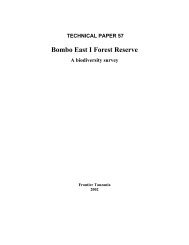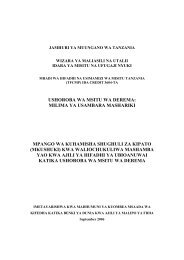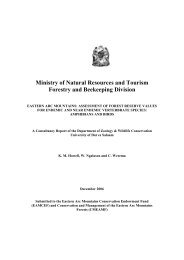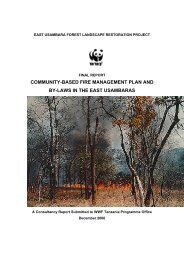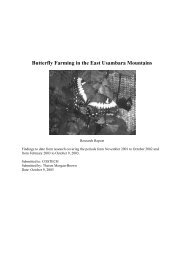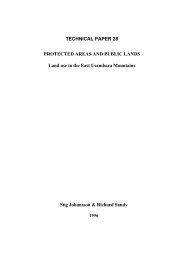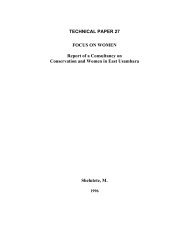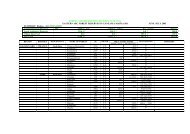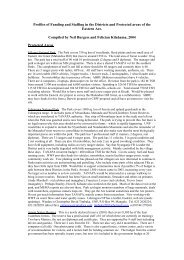Development of Sustainable Forest Use Strategies - Eastern Arc ...
Development of Sustainable Forest Use Strategies - Eastern Arc ...
Development of Sustainable Forest Use Strategies - Eastern Arc ...
Create successful ePaper yourself
Turn your PDF publications into a flip-book with our unique Google optimized e-Paper software.
EXECUTIVE SUMMARY<br />
In recent years sustainability in forest resource utilization has become a major concern<br />
worldwide. There is an expectation that forests are healthy and sustainable when biotic<br />
and abiotic influences do not threaten the attainment <strong>of</strong> conservation objectives at<br />
present or in the future. The <strong>Eastern</strong> <strong>Arc</strong> Mountain <strong>Forest</strong>s (EAMFs) and Grasslands<br />
provide a number <strong>of</strong> resources for the people. The value <strong>of</strong> these resources, and the<br />
poverty <strong>of</strong> the people living in the Mountains, creates an unsustainable use <strong>of</strong> many<br />
forest products. However, the exact nature <strong>of</strong> the unsustainable use and the species that<br />
are targeted is not synthesized. Moreover, strategies for addressing the unsustainable<br />
use have not been proposed. Therefore, the objectives <strong>of</strong> this study were to identify types<br />
<strong>of</strong> unsustainable resource uses, assess the extent and severity <strong>of</strong> problems caused by<br />
invasive species and propose strategies that would address the unsustainable use <strong>of</strong><br />
forest products and any invasive species found in the study area.<br />
Information was collected through review <strong>of</strong> policies, laws and available scholarly<br />
information on the intended issues with minimal field visits supported by interviews and<br />
participant observations. A purposive sampling design was used to select samples <strong>of</strong><br />
forest blocks for ground truthing after a literature screening exercise, which helped to<br />
identify information gaps with regard to major themes <strong>of</strong> the study (i.e., forest uses and<br />
invasive species). In each sampled forest, groups <strong>of</strong> villagers and individual key<br />
informants were selected on the basis <strong>of</strong> availability and willingness to discuss with<br />
researchers during the visits. Both primary and secondary data were collected to address<br />
the specific study objectives. These were intended to cover three major dimensions<br />
namely social, economic and ecological. Social and economic dimensions focused on<br />
the forest resource users whereas the ecological dimension focused on the forest land<br />
and resources therein. The study was guided by a conceptual framework.<br />
The review <strong>of</strong> policies and laws related to forest conservation indicates that there are<br />
some distinct deficiencies, which make them fail to comply with sustainable use <strong>of</strong> forest<br />
products. There is relatively big disparity between the statements and directives in<br />
policies and laws and the actual situation on the ground. Responsibilities and<br />
answerabilities <strong>of</strong> government <strong>of</strong>ficials in the field have a lot to be desired. Where the<br />
degree <strong>of</strong> forest use is specified, the mechanism for follow-up or implementation is not<br />
clearly stated. These flaws in policy directives and laws jeopardize the attainment <strong>of</strong><br />
sustainable forest use in the EAMFs.<br />
The major types <strong>of</strong> unsustainable forest uses include illegal logging, illegal hunting or<br />
poaching, tree cutting for commercial firewood, medicinal plants, and encroachment for<br />
farming. Using a set <strong>of</strong> sustainability indicators, it was found that the current logging<br />
practices in the EAMFs were illegal and unsustainable. Several incidences <strong>of</strong> illegal<br />
logging were observed particularly in East Usambara, South Pare, Nguru, Ukaguru and<br />
Mahenge. Trees in upper and sensitive catchment areas were harvested for timber, as<br />
was noted in river valleys in East Usambara. It was reported that among the incidences <strong>of</strong><br />
poaching <strong>of</strong>fences committed for a period <strong>of</strong> ten years, illegal logging (48%) was more<br />
commonly committed in Udzungwa Mountain forest block. Major timber species that are<br />
i



